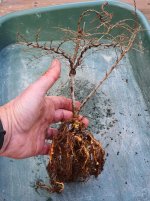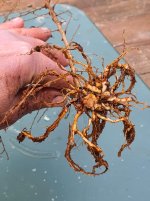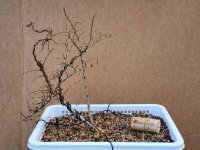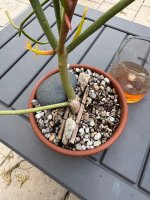AGentleman
Yamadori
Hi everyone,
I repotted this Seiju Elm today.


I did my best to comb the roots out radially, removing any that were growing downward. I also chopped off the thicker, longer roots. In hindsight, I’m a bit worried I may have taken off too much.


Soil mix:
• Equal parts pumice, scoria (lava rock?), and pine bark
• Plus 1 part zeolite (3:3:3:1 ratio)
I also mixed in some finely chopped sphagnum moss and spread that over the top layer.
Since there weren’t enough roots to anchor the tree securely, I wired it to the pot rather than tying it down as I’ve seen done.

I originally planned to use a large air-pruning grow pot, but decided it was oversized for this tree’s current size.
I’d really appreciate any feedback because I’m about to plant a slightly larger Seiju Elm in the ground and want to avoid killing that one!
Thanks in advance for your time and thoughts!
Greg
I repotted this Seiju Elm today.


I did my best to comb the roots out radially, removing any that were growing downward. I also chopped off the thicker, longer roots. In hindsight, I’m a bit worried I may have taken off too much.


Soil mix:
• Equal parts pumice, scoria (lava rock?), and pine bark
• Plus 1 part zeolite (3:3:3:1 ratio)
I also mixed in some finely chopped sphagnum moss and spread that over the top layer.
Since there weren’t enough roots to anchor the tree securely, I wired it to the pot rather than tying it down as I’ve seen done.

I originally planned to use a large air-pruning grow pot, but decided it was oversized for this tree’s current size.
I’d really appreciate any feedback because I’m about to plant a slightly larger Seiju Elm in the ground and want to avoid killing that one!
Thanks in advance for your time and thoughts!
Greg



